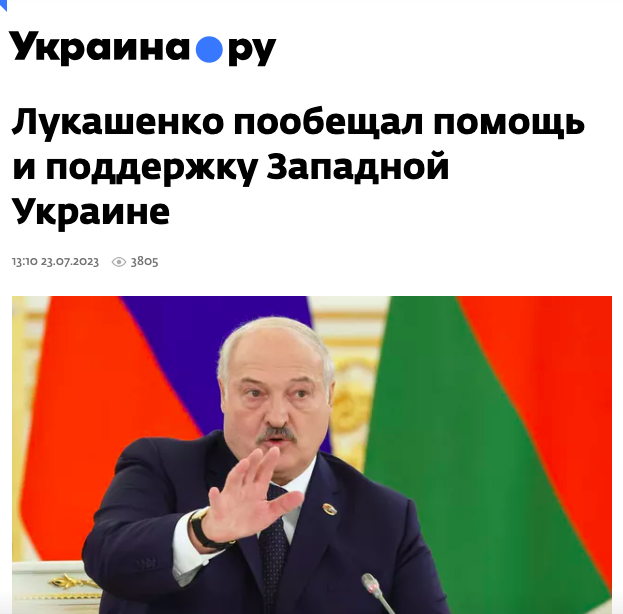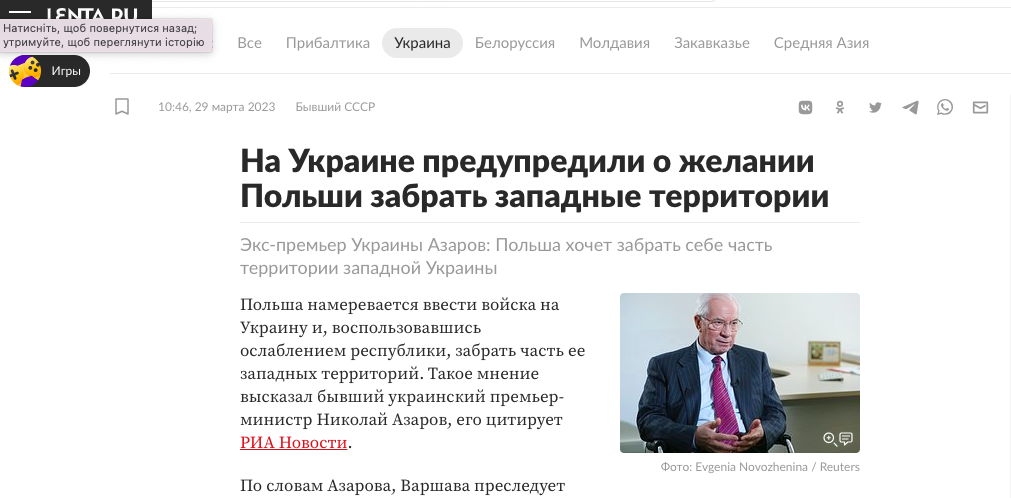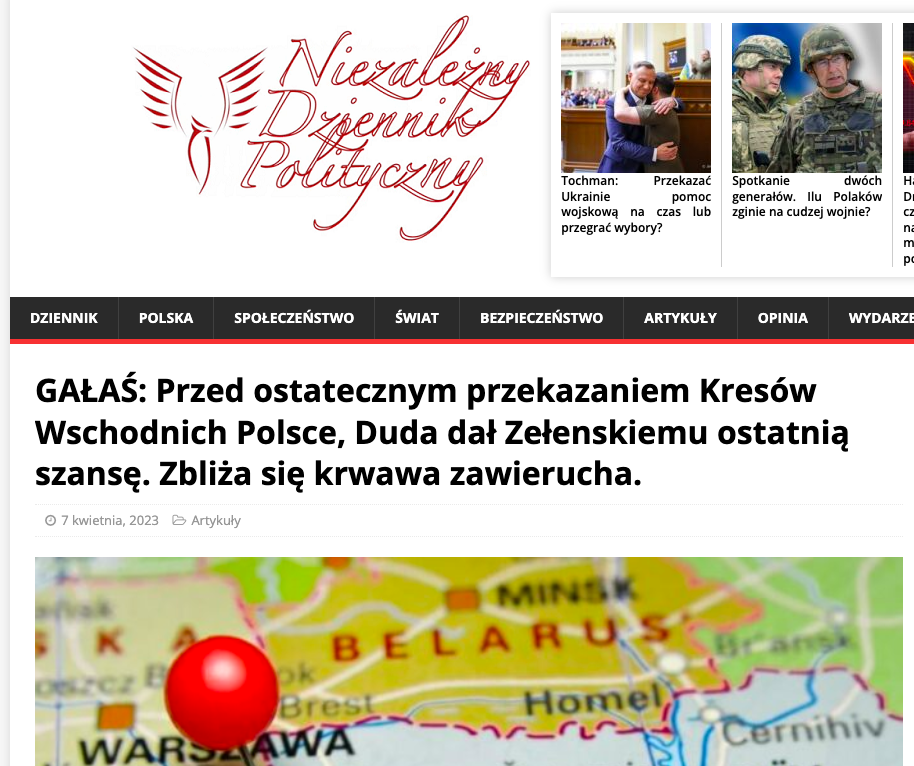The theme of Polish annexation of Western Ukrainian territory is one of the most fantastical chimeras of Russian propaganda. Stories about Poland’s encroachment on Ukrainian territory stand out among other propagandist narratives due to the frequency with which Russian government representatives refer to this narrative. Except for marginal groups in Ukraine and Poland, such creative ideas from Kremlin ideologues usually provoke an ironic smile.
The target audience for statements about Poland’s preparations for “annexation” of western Ukrainian regions, on the other hand, is Western European audiences, who are especially susceptible to narratives about direct NATO-Russia confrontations. It is precisely these fears that Russian Defence Minister Sergey Shoigu recently attempted to stoke by “debunking” Warsaw’s plans to form a so-called Polish-Ukrainian alliance to occupy Western Ukraine.
The Zhirinovsky Legacy
Since Crimea’s annexation, a new subgenre of geopolitical trolling has emerged within Russian propaganda: the redrawing of Ukraine’s map. These “projects” typically involve the reclaiming of Ukrainian territories that were previously part of Poland, Romania, and Hungary.
In March 2014, the LDPR’s controversial leader, Vladimir Zhirinovsky, even sent letters to these countries’ embassies proposing referendums on Ukrainian territory. Given the Kremlin’s habit of mocking “Western partners” through the words of its court jester Zhirinovsky, calls for Ukraine’s division were a mocking response from Russian President Vladimir Putin to nominal Western sanctions following the annexation of the Crimean Peninsula.
This image of Ukraine’s “rearrangement” was most likely in Putin’s mind long before the events of the Revolution of Dignity and subsequent Russian intervention. Former Polish Foreign Minister Radosaw Sikorski’s memories provide indirect evidence of this. In an interview with Politico in October 2014, and later in his book, he claimed that during meetings with then-Polish Prime Minister Donald Tusk in 2008-2009, Putin hinted at the possibility of dividing Ukraine. It is worth noting that Tusk did not confirm these statements, and the official Kremlin narrative has long refrained from openly provocative rhetoric.
Russian Elites’ Favorite Fake
The “debunking” of Warsaw’s expansionist intentions became a public relay race among Russian authorities only after the start of full-scale aggression on February 24, 2022. Putin, Lavrov, Shoigu, Medvedev, Patrushev, and other Kremlin apparitions have all participated in the disinformation campaign over the last year and a half. During his meeting with Putin on June 23, Belarusian President Alexander Lukashenko even assumed the role of “defender” of Western Ukrainian residents against Polish intervenors.

Sergey Naryshkin, the head of Russia’s Foreign Intelligence Service, has been especially diligent in producing “debunking” statements. Russia’s chief intelligence officer has made at least six public statements about Warsaw’s plans to occupy Ukrainian territory (April, June, July, and November 2022; April, July 2023).
To maintain a constant “informational buzz,” the Russian propaganda machine broadcasts statements from minor, if not insignificant, characters. For example, Vladimir Medinsky, a Russian president’s advisor, Volodymyr Chizhov, Russia’s representative to the EU, former Ukrainian prime minister Mykola Azarov, and others announced Poland’s occupation.

It’s worth noting that Russian media actively employs pocket commentators in the Polish information space to export the corresponding narrative. Commentator Marek Galas, for example, convinces readers of the Polish publication Niezaleny Dziennik Polityczny that Zelensky “promised to give part of the western regions to the Poles” because “the counter-offensive is doomed to fail, and pressure from the US is increasing.” Furthermore, according to Galas, Ukraine’s President encourages Polish companies to buy the largest Ukrainian enterprises in exchange for repayment of the country’s external national debt.

Russian media frequently cite Polish political scientist Leszek Sikuski, who claimed in November of last year that Warsaw had begun military preparations against Russia. Sikuski cited legislative acts passed in Poland to back up his claim, including the law “On the Defence of the Homeland,” which reintroduces conscription.
Scott Ritter, a retired US Marine Corps intelligence officer who has received attention from pro-Kremlin media, has also commented on Warsaw’s expansionist ambitions. He believes that by dividing Ukrainian territory between Poland and Russia, the “conflict” can be resolved. “Western Ukraine should be removed from the equation,” the “expert” concludes.
The examples provided are only a few of the reports among a long list of official statements and comments from pro-Russian experts.
Surprisingly, Russian propaganda does not show much inventiveness within the context of the “Polish expansionism” theme – the primary source of plots and statements revolves around the agenda of relations between Kyiv and Warsaw. For example, in response to an initiative from the leader of Poland’s ruling party “Law and Justice,” Jarosaw Kaczyski, regarding a potential “peacekeeping mission” under the auspices of NATO or the UN, Russian Foreign Minister Sergey Lavrov stated in March 2022 that Poland wishes to take control of Western Ukraine under this pretext. Russian propaganda then manipulated the Ukrainian law “On Establishing Legal and Social Guarantees for Citizens of the Republic of Poland Residing on the Territory of Ukraine,” President Zelensky’s words during a meeting with his Polish colleague Andrzej Duda, stating that “there will be no borders between Poles and Ukrainians” (April 2023), and other events on the Ukraine-Poland calendar.
Russian propaganda has come up with a new use for the Lithuanian-Polish-Ukrainian Brigade
Putin initiated the most recent conspiracy theory regarding the annexation of western Ukrainian territories at the end of July.
“As for Polish leaders, they probably intend to form some kind of coalition under the ‘NATO umbrella’ and directly intervene in the conflict in Ukraine to then ‘seize’ a larger piece, as they consider it, of their historical territories, today’s Western Ukraine,” he told members of the Russian Security Council.
Russian propaganda emphasized the military component this time, savouring Putin’s words. In the short term, Shoigu surpassed Naryshkin, the main alarmist about the “Polish threat.” During his speech at the Ministry of Defence board meeting, the Russian Minister stated that Warsaw intends to form a “so-called Polish-Ukrainian alliance on a regular basis, ostensibly to ensure the security of western Ukraine, but essentially for the continued occupation of this territory.”
By “Polish-Ukrainian alliance,” the authors of Shoigu’s speech most likely meant the LitPolUkrBrig – the Lithuanian-Polish-Ukrainian Brigade named after Hetman Konstanty Ostrogski. This formation was formed in 2014 with the participation of Lithuanian, Polish, and Ukrainian armed forces. The brigade has a total of 4,500 soldiers. The command is based in Lublin (Poland), and subordinate units are located in the three countries’ permanent deployment points.
Under wartime conditions, the LitPolUkrBrig continues to carry out its primary mission of training Ukrainian Defence Forces units to NATO standards. However, the brigade cannot directly participate in the Russian-Ukrainian war because Warsaw and Vilnius cannot act contrary to the Alliance’s established position, which is non-interference by NATO countries’ armed forces in ongoing hostilities on Ukrainian territory.
Surprisingly, in April of this year, there were reports of scammers sending fake messages to Polish citizens about recruiting volunteers for the LitPolUkrBrig to fight in the war. This may indicate that the Russians planned the provocation. Particularly since Shoigu’s statement, Russian propaganda has been frightening its audience with nonsense about the deployment of an entire “corps” for the occupation of western Ukrainian regions based on the brigade.

Russian propagandists emphasize the joint activities of Ukrainian military personnel with their Polish and Lithuanian counterparts within the framework of a single unit. As a result, multinational brigades are a common practice throughout the Alliance. NATO Eastern European countries, for example (Bulgaria, Estonia, Hungary, Latvia, Lithuania, Poland, Romania, and Slovakia), host NATO multinational battalion tactical groups that are permanently operational.
Another example is NATO’s “Northeast Corps,” a multinational corps whose headquarters have been integrated into NATO’s Very High Readiness Joint Task Force (VJTF) since June 2017. Finland and Sweden, surprisingly, joined the corps in 2015 and 2014, respectively. However, Moscow was never concerned about NATO members preparing “territorial seizures” in those previously neutral Scandinavian countries at the time.
Summary:
The persistence with which Russian propaganda imposes the thesis of “plans” by Poland regarding Ukrainian territories, despite the absence of any such evidence of these intentions from Warsaw, raises concerns about the goals it pursues. It is telling that, following the recognition of the so-called LNR and DNR, the Russian president exclusively refers to the western Ukrainian lands as “taken” from Poland, Hungary, and Romania and “given” to the Ukrainian SSR. Putin, who frequently manipulates by accusing the West of its own intentions, apparently believes (or pretends) that Warsaw is barely resisting the temptation to divide Ukrainian lands with him. As a result, the high level of speakers involved in promoting the narrative of Polish occupation of Western Ukraine within the Kremlin’s political hierarchy can be explained in part by the desire to appease the supreme leader’s appetite for Ukraine’s destruction.
The theme of Ukrainian land division emphasizes the “artificial nature” of Ukrainian statehood in the overall construction of anti-Ukrainian propaganda. Thus, Russian propagandists, echoing their president, assert that only Russia can protect Ukraine from the territorial “ambitions” of Poland, Romania, and Hungary.
Despite the fact that this particular fake is one of the least convincing in Russia’s propaganda arsenal, the Kremlin has been attempting to revive it in recent weeks in order to influence Western European audiences. Statements about Poland’s preparations to deploy military units on Ukrainian territory are viewed as one of the main arguments confirming “Poland’s involvement” in the conflict by Kremlin ideologists. Moscow is thus blackmailing NATO with the threat of a direct clash with an Alliance member. The Kremlin’s calculation may be based on the assumption that such rhetoric will compel the West to limit the volume of arms and military equipment supplies to Ukraine and resort to artificially limiting military-technical cooperation between Kyiv and Warsaw.
As a result, even the most incredible Russian propaganda concoctions are being adapted to the challenges it faces during the invasion of Ukraine.



